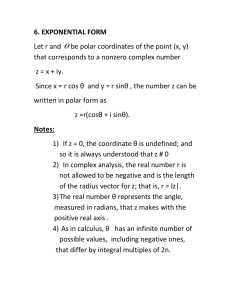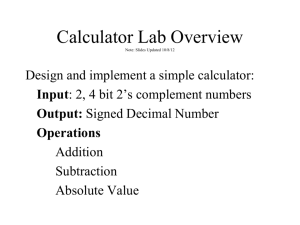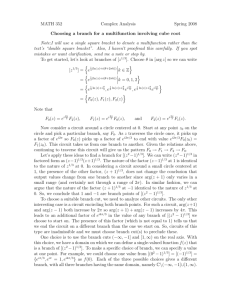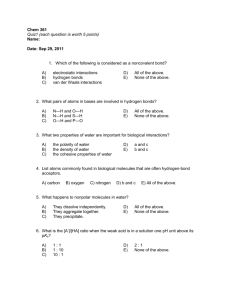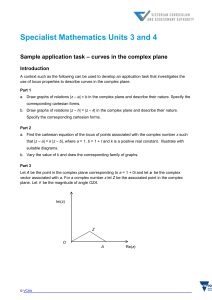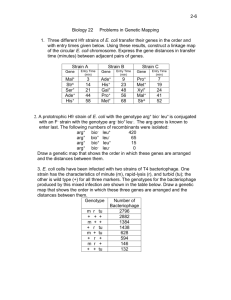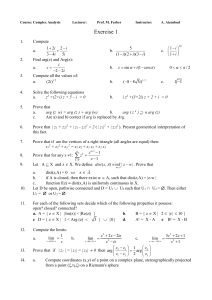HOMEWORK 3: SOLUTIONS 1. Find exactly all roots of the
advertisement
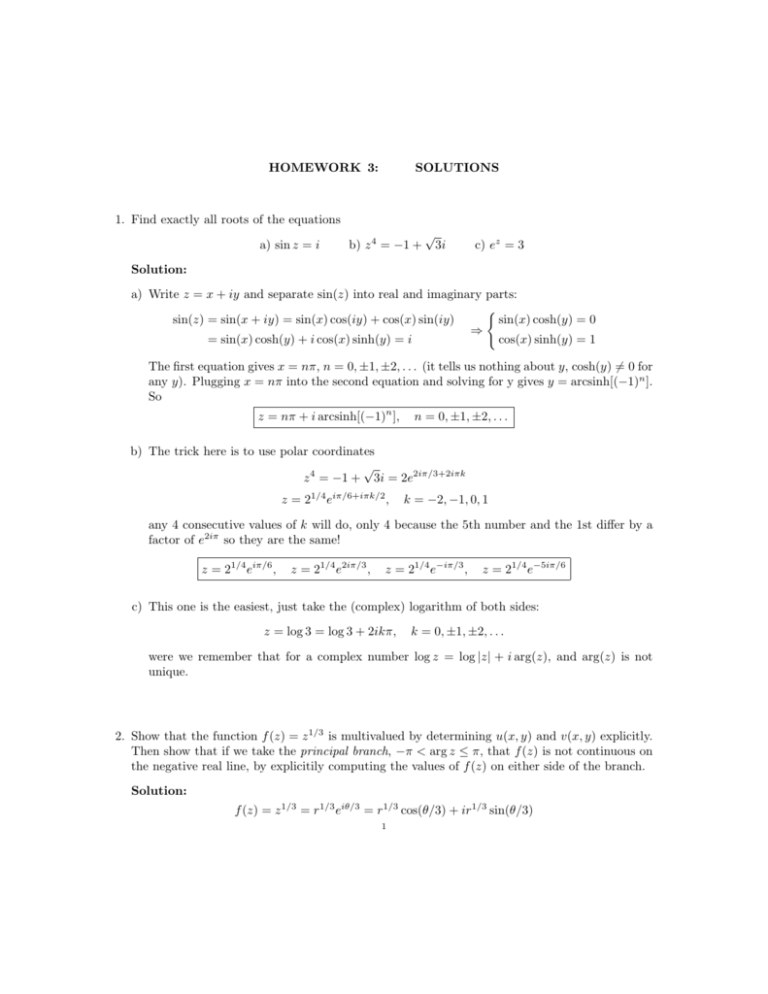
HOMEWORK 3: SOLUTIONS 1. Find exactly all roots of the equations a) sin z = i b) z 4 = −1 + √ 3i c) ez = 3 Solution: a) Write z = x + iy and separate sin(z) into real and imaginary parts: ( sin(z) = sin(x + iy) = sin(x) cos(iy) + cos(x) sin(iy) sin(x) cosh(y) = 0 ⇒ = sin(x) cosh(y) + i cos(x) sinh(y) = i cos(x) sinh(y) = 1 The first equation gives x = nπ, n = 0, ±1, ±2, . . . (it tells us nothing about y, cosh(y) 6= 0 for any y). Plugging x = nπ into the second equation and solving for y gives y = arcsinh[(−1)n ]. So z = nπ + i arcsinh[(−1)n ], n = 0, ±1, ±2, . . . b) The trick here is to use polar coordinates √ z 4 = −1 + 3i = 2e2iπ/3+2iπk z = 21/4 eiπ/6+iπk/2 , k = −2, −1, 0, 1 any 4 consecutive values of k will do, only 4 because the 5th number and the 1st differ by a factor of e2iπ so they are the same! z = 21/4 eiπ/6 , z = 21/4 e2iπ/3 , z = 21/4 e−iπ/3 , z = 21/4 e−5iπ/6 c) This one is the easiest, just take the (complex) logarithm of both sides: z = log 3 = log 3 + 2ikπ, k = 0, ±1, ±2, . . . were we remember that for a complex number log z = log |z| + i arg(z), and arg(z) is not unique. 2. Show that the function f (z) = z 1/3 is multivalued by determining u(x, y) and v(x, y) explicitly. Then show that if we take the principal branch, −π < arg z ≤ π, that f (z) is not continuous on the negative real line, by explicitily computing the values of f (z) on either side of the branch. Solution: f (z) = z 1/3 = r1/3 eiθ/3 = r1/3 cos(θ/3) + ir1/3 sin(θ/3) 1 HOMEWORK 3: SOLUTIONS 2 where θ is measured in the interval −π < θ ≤ π. Now if we take the limit as θ goes to the branch cut from above or below we get: √ ! 1 i 3 iθ 1/3 + lim f (re ) = r θ→π 2 2 √ ! 1 i 3 lim f (reiθ ) = r1/3 − θ→−π 2 2 since the limits are not the same, the function is not continuous along the branch cut. 3. Show that u(x, y) = x3 y − xy 3 is a harmonic function (i.e. ∆u = 0). Use the Cauchy-Riemann equations to construct a function v(x, y) such that f (z) = u(x, y) + iv(x, y) is analytic. The function v is called the harmonic conjugate of u. Solution: ∆u = uxx + uyy = 6xy + (−6xy) = 0 so u is harmonic. Now we choose v according to the Cauchy Riemann equations. vy = ux = 3x2 y − y 3 −vx = uy = x3 − 3xy 2 3 2 2 1 4 x y − y + c1 (x) 2 4 1 4 3 2 2 v = − x + x y + c2 (y) 4 2 v= Comparing the two equations we find that 1 3 1 v(x, y) = − x4 + x2 y 2 − y 4 . 4 2 4 The functions u and v are the real and imaginary parts of the function f (z) = − 4i z 4 . ∂ ∂ ∂ ∂ ¯ for any analytic function 4. Let ∂ = 12 ∂x − i ∂y and ∂¯ = 12 ∂x + i ∂y . Compute ∂f and ∂f f (z) = u(x, y) + iv(x, y). Solutions: ∂ u x + vy vx − uy 1 ∂ (u + iv) = −i +i = ux + ivx = vy − iuy 2 ∂x ∂y 2 2 ¯ = 1 ∂ + i ∂ (u + iv) = ux − vy + i vx + uy = 0 ∂f 2 ∂x ∂y 2 2 ∂f = 5. Compute, without theorems, z = −1 to z = 1: a) the straight line ´ C f (z)dz for f (z) = 1 z−i/2 and C each of the following paths from b) the upper semi-circle c) the lower semi-circle. HOMEWORK 3: SOLUTIONS 3 Explain why some of your answers are equal and others are different. Solutions: Skip this one! ˆ 6. Determine an upper bound for 1 for C the semicircle of radius R in the upper halfplane. z2 + 1 C Calculate it’s limit as R → ∞. Solution: Parameterize the path by z = Reit . ˆ ˆ π ˆ |Rieit dt| 1 dz ≤ ≤ z2 + 1 |R2 e2it + 1| 0 C 0 π R πR dt = 2 . −1 |R − 1| R2 So if we take the limit as R → ∞: ˆ πR 1 ≤ lim dz lim R→∞ |R2 − 1| = 0. 2 R→∞ + 1 z C ˛ 7. Compute C z 3 e−z where C is the c.c.w. oriented circle z3 + 8 (a) |z| = 1, (b) |z + i| = 2 (c) |z + 2| = 1 Solution: The three roots of z + 8 = 0 are z1 = −2, z2 = 2eiπ/3 , z3 = 2e−iπ/3 . 3 Now we compute the three integrals: (a) All three roots are outside the circle |z| = 1 so ¸ z 3 e−z |z|=1 z 3 +8 = 0. (b) The root z3 = 2e−iπ/3 is inside the circle |z + i| = 2 and the others are outside. So we can use the C.I.F. to write ˛ z 3 e−z 4iπ −iπ/3 −1+i√3 z 3 e−z = = 2iπ · e e 3 iπ/3 3 (z + 2)(z − 2e ) z=2e−iπ/3 |z+i|=2 z + 8 (c) This is the same as the previous example except now the root inside the circle is z1 = −2: So we can use the C.I.F. to write ˛ z 3 e−z z 3 e−z 4iπ 2 = 2iπ · =− e 3 iπ/3 −iπ/3 3 (z − 2e )(z − 2e ) z=−2 |z+2|=1 z + 8 8. Suppose C1 and C2 are oriented curves in C with a nontangential intersection at z0 and suppose that f (z) is analytic in a neighborhood of z0 . Let z1 (t) and z2 (t) be parameterizations of C1 and C2 respectively, such that z10 (t) 6= 0 and z20 (t) 6= 0 and z1 (t0 ) = z2 (t0 ) = z0 , and let w1 (t) = f (z1 (t)) and w2 (t) = f (z2 (t)) be the image of each curve under the mapping w = f (z). Show that if f 0 (z0 ) 6= 0 then a) wj0 (t0 ) 6= 0. HOMEWORK 3: SOLUTIONS 4 b) arg wj0 (t0 ) − arg zj0 (t0 ) = arg f 0 (z0 ), for j = 1, 2. c) arg z20 (t0 ) − arg z10 (t0 ) = arg w20 (t0 ) − arg w10 (t0 ). Draw a diagram that includes the curves and derivatives (tangent vectors) at z0 and w0 = f (z0 ). Since zj0 (t) and wj0 (t) are oriented tangent vectors to the curves zj (t) and wj (t) the last result shows that analytic functions f (z) are conformal, i.e., they preserve the angles between curves in both magnitude and direction wherever f 0 (z) 6= 0. Solution a) By the chain rule wj0 (t0 ) = f 0 (zj (t0 )zj0 (t0 ) = f 0 (z0 )zj0 (t0 ). Since zj0 (t0 ) 6= 0 and f 0 (z0 ) 6= 0 it follows that wj0 (t0 ) 6== 0. b) Take the argument of each side: arg wj0 (t0 ) = arg f 0 (z0 )zj0 (t0 ) = arg f 0 (z0 ) + arg zj0 (t0 ) rearranging gives arg wj0 (t0 ) − arg zj0 (t0 ) = arg f 0 (z0 ). c) To get this simply subtract the above equation with j = 2 from the same equation with j = 1: (arg w20 (t0 ) − arg z20 (t0 )) − (arg w10 (t0 ) − arg z10 (t0 )) = arg f 0 (z0 ) − arg f 0 (z0 ) Simplifying gives arg z20 (t0 ) − arg z10 (t0 ) = arg w20 (t0 ) − arg w10 (t0 ).
